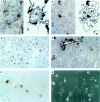Periacinar stellate shaped cells in rat pancreas: identification, isolation, and culture
- PMID: 9771417
- PMCID: PMC1727174
- DOI: 10.1136/gut.43.1.128
Periacinar stellate shaped cells in rat pancreas: identification, isolation, and culture
Abstract
Background: The pathogenesis of pancreatic fibrosis is unknown. In the liver, stellate cells (vitamin A storing cells) play a significant role in the development of fibrosis.
Aims: To determine whether cells resembling hepatic stellate cells are present in rat pancreas, and if so, to compare their number with the number of stellate cells in the liver, and isolate and culture these cells from rat pancreas.
Methods: Liver and pancreatic sections from chow fed rats were immunostained for desmin, glial fibrillary acidic protein (GFAP), and alpha smooth muscle actin (alpha-SMA). Pancreatic stellate shaped cells were isolated using a Nycodenz gradient, cultured on plastic, and examined by phase contrast and fluorescence microscopy, and by immunostaining for desmin, GFAP, and alpha-SMA.
Results: In both liver and pancreatic sections, stellate shaped cells were observed; these were positive for desmin and GFAP and negative for alpha-SMA. Pancreatic stellate shaped cells had a periacinar distribution. They comprised 3.99% of all pancreatic cells; hepatic stellate cells comprised 7.94% of all hepatic cells. The stellate shaped cells from rat pancreas grew readily in culture. Cells cultured for 24 hours had an angular appearance, contained lipid droplets manifesting positive vitamin A autofluorescence, and stained positively for desmin but negatively for alpha-SMA. At 48 hours, cells were positive for alpha-SMA.
Conclusions: Cells resembling hepatic stellate cells are present in rat pancreas in a number comparable with that of stellate cells in the liver. These stellate shaped pancreatic cells can be isolated and cultured in vitro.
Figures


References
Publication types
MeSH terms
Substances
LinkOut - more resources
Full Text Sources
Other Literature Sources
Miscellaneous
